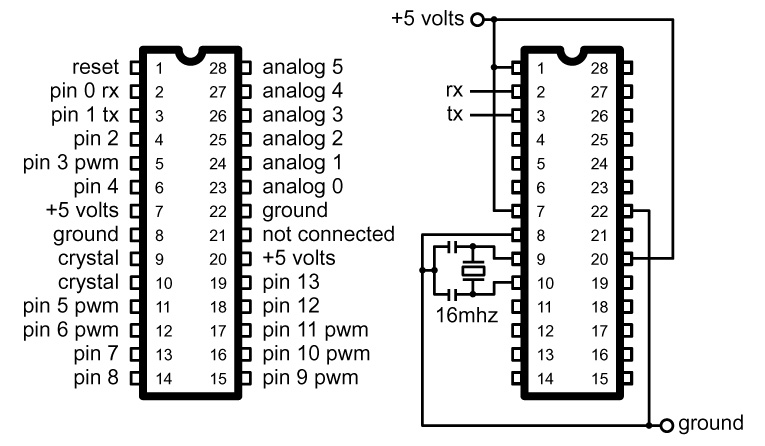Standalone Arduino

Here are two drawings that show the pinout, or the location of each pin on the chip itself, of the Arduino microcontroller and the most basic circuit diagram. There are some tradeoffs by using this method, like having to program the chip in the Arduino before unplugging it and plugging it into the board. The most complicated part of the process is wiring up the crystal or resonator. There are 2 possible choices here, both work the same but I find the crystal easier to hook up on a breadboard. I will cover the crystal in class (mainly because I dont have a resonator on me) but a resonator looks like this:

Both pins on the outside go to the Arduino chip (pin 9 & 10) and the middle pin connects to ground.
The rest of the hookup is pretty straightforward, just make sure the right pins are properly wired to either +5v or Ground.
There are a couple of components to make this work.
Crystal or Resonator:
Option 1:
16mhz Ceramic Resonator Jameco# 324662
OR
Option 2:
16mhz Crystal HC49/US Jameco# 325139
20pF Ceramic Disc Capacitors Jameco # 332321 (x2)
You will also need a socket for the Arduino chip:
28pin DIP IC Socket Jameco# 683171 (<-- You wont need a socket if this is only going into a breadboard.)
To power it up you need a clean stable source of 5 volts DC. This means that you either pick up a switching 5v DC power supply from our favorite JK Electronics, mail order one from Jameco or you will have to wire up a voltage regulator. Page 254 of Phys Comp has a nice layout of a 7805 voltage regulator with a couple decoupling capacitors.
For the voltage regulator you will need these parts:
7805 Voltage Regulator Jameco# 51263
10uF Electrolytic Capacitor Jameco# 94220
1uF Electrolytic Capacitor Jameco# 94160
Finally you will need something to stick all these parts into. Feel free to use anything you want: plastic, wood, a herring... The easiest method is to just use a spare breadboard but the second easiest method is to permantly solder everything together using a copper clad perf board available at Radio Shack. These have holes drilled in a phenolic substrate with little copper rings, or pads, on one side.
213 Hole Mini Board Radio Shack# 276-148 (This is small and square.)
OR
417 Hole Board Radio Shack# 276-150 (This is kinda like your breadboard.)
Ok thats about it. I will show how this all goes together in class on Monday, DEC 3.
Comments (0)
You don't have permission to comment on this page.